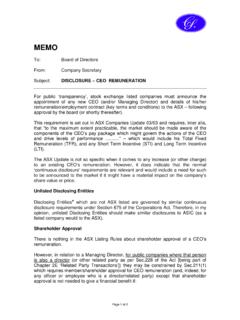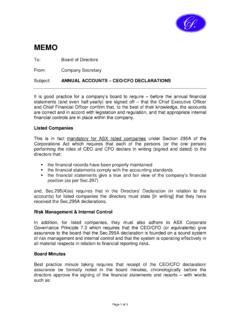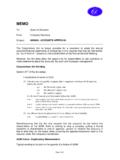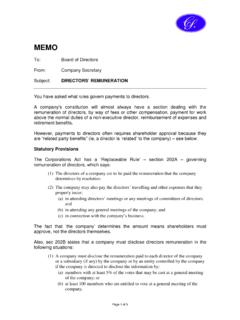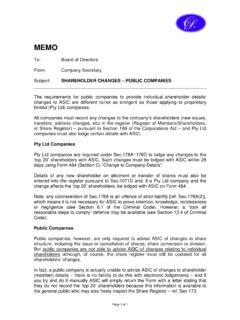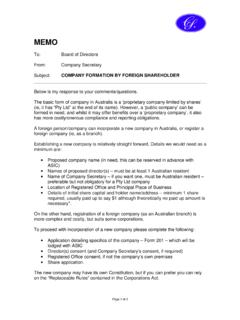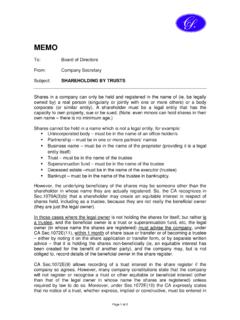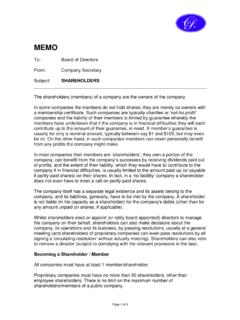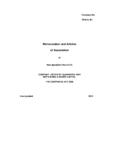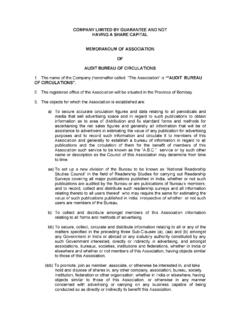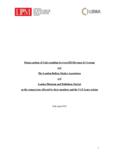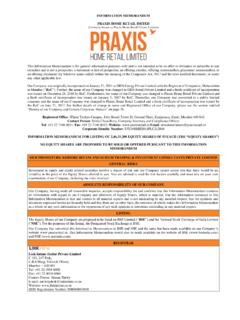Transcription of Memo & Articles of Association
1 Page 1 of 3 MEMO To: Board of Directors From: Company Secretary Subject: memorandum & Articles OF Association Prior to 1 July 1998 in Australia what is now known as a company s Constitution was called the memorandum & Articles of Association ( M&A ) , actually 2 separate documents ( memorandum of Association and Articles of Association ). In many countries around the world M&A still are used. Whilst the 1 document ( , a Constitution) is what companies registered since 1 July 1998 in Australia have as the rules to guide directors and officers in the operation and internal management of the company, companies registered before that date still have M&A unless they have been repealed and/or replaced by a [new] Constitution. Companies that have not replaced their [old] M&A may well find that there are a number of provisions which they are not following but should be because such have fallen out of favour, or are no longer required, and are not mentioned in [modern] Constitutions.
2 Typically one such provision relates to the need for an AGM which Proprietary Limited (Pty Ltd) companies no longer need under the Corporations Act, and would not generally be included in a Pty Ltd company s Constitution these days but most M&As would have such requirement because, amongst other things, that was mandatory under the Act in the pre-July 1998 days. memorandum of Association A memorandum usually listed the objects for which a company was established to undertake, and in the old days it was often seen as being outside the scope of a company s capabilities ( , ultra vires) to do anything not spelt out in its M&A. These days a Constitution does not usually list objects, and it is generally taken that a company can do anything that a natural person could do.
3 Articles of Association The Articles usually covered everything to do with the operational framework of a company, including: Corporate powers Shares issue, allotment, liability, class rights, transfers General meetings voting, proxies Directors appointment, powers, meetings Page 2 of 3 Company Secretary, execution of documents, bank signatories Corporate organisational matters Constitution These days most companies have a Constitution or they may, instead, adopt the Replaceable Rules . For a public company, when it is formed, any Constitution must be lodged with ASIC. This original Constitution must be signed by all the original members of the company. Also, any subsequent (member approved) changes/modifications to, or [repealing and] replacement of, the Constitution must be lodged with ASIC too.
4 A proprietary company cannot lodge its Constitution with ASIC. Any original Constitution, and any changes, must be retained at the company s office and a copy must be provided to any member requesting it (section 139). Replaceable Rules In lieu of a Constitution a company may simply adopt the Replaceable Rules in the Corporations Act (section 135) or use a combination of both (section 134). Note: there are additional sections of the Act which cover the management of companies and must also be complied with; as well as any applicable common law provisions. A table of Replaceable Rules is found in section 141. Note, a specific provision in a Constitution can override the Replaceable Rules. Also, under section 135(1) the Replaceable Rules do not apply to proprietary companies where the one person is the sole director and sole shareholder, although a Constitution may be adopted but see sections 198E, 201F & 202C.
5 Contract with Stakeholders The Constitution / Replaceable Rules has the effect of a contract (section 140) between: the company and each member/shareholder; the company and each Director; the company and the Company Secretary; a member and each other member. Changes to a Constitution require a special resolution (at least 75% of shareholders / members approving). Page 3 of 3 DISCLAIMER The comments in this memo reflect some commercial aspects and observations on the matter experienced or observed by the writer in practice as he understands them. The information is given as a guide only and does not represent a definitive or legal view of any of the issues raised, covered or referred to and the reader is urged to seek his own professional advice on all aspects of, or pertaining to, this and any related matter.
6 Copyright Company Secretarial Services Pty Ltd ABN: 41 074 535 345
